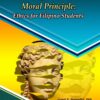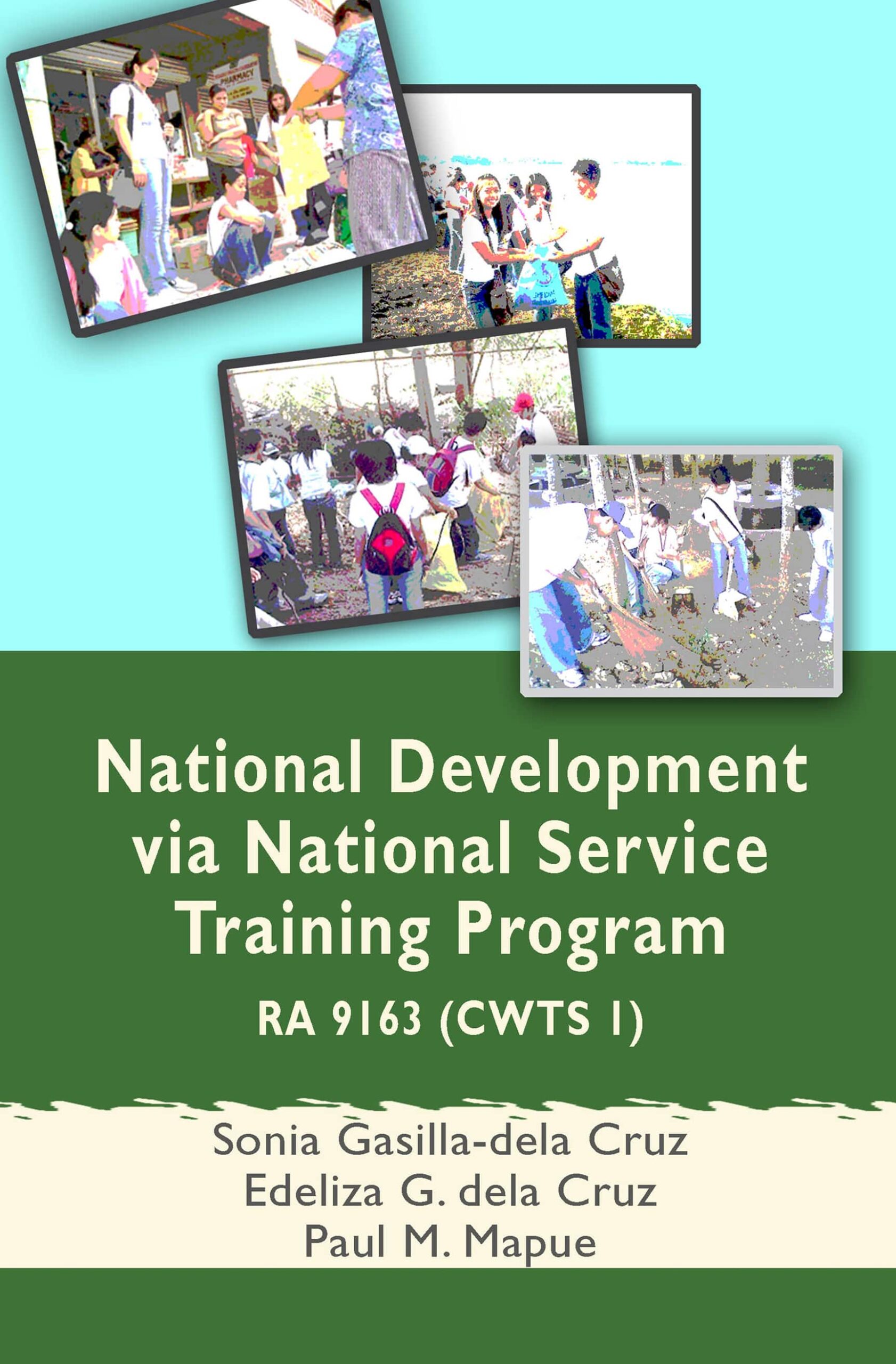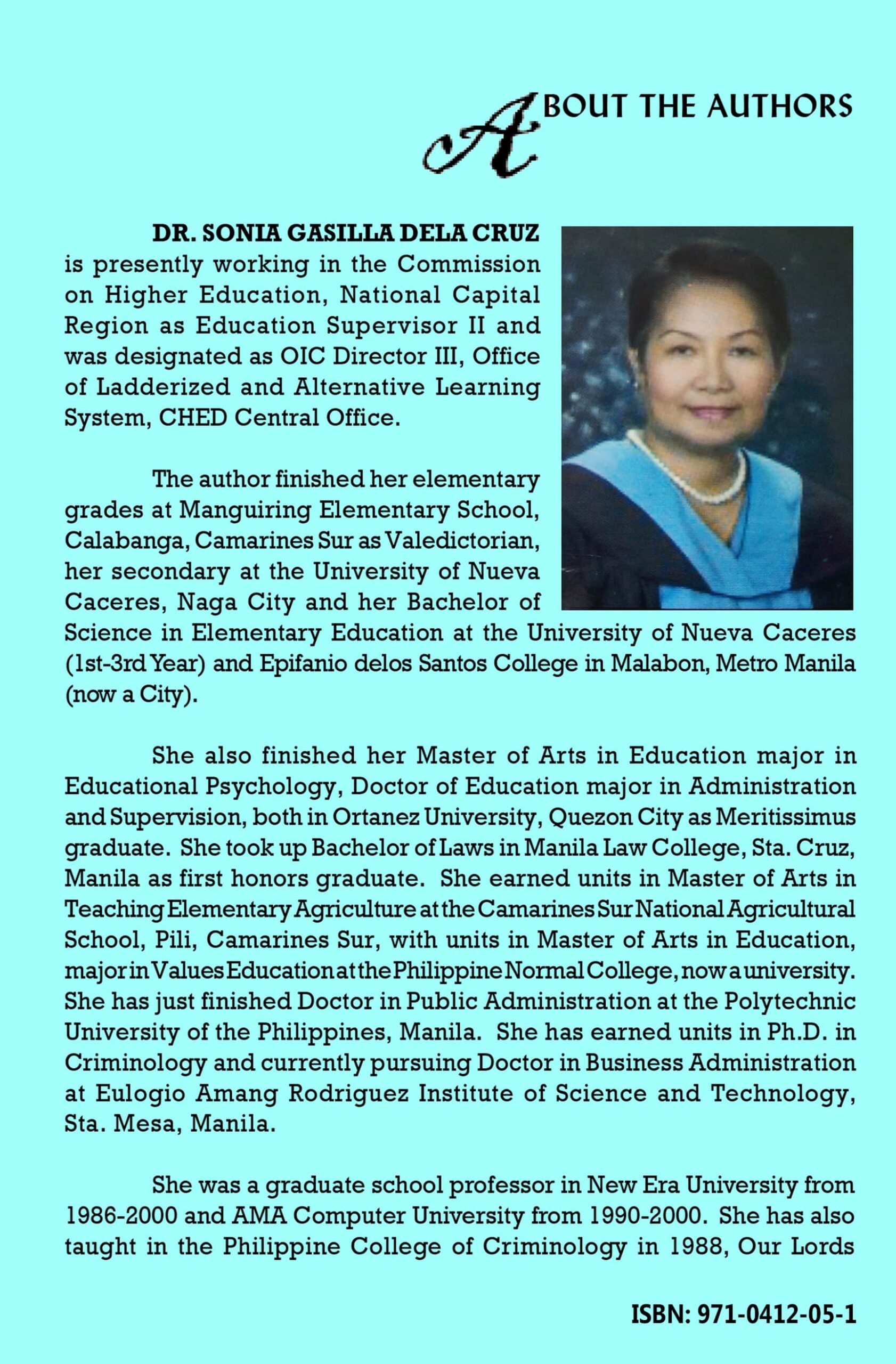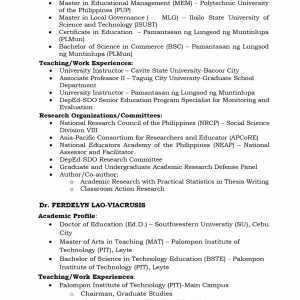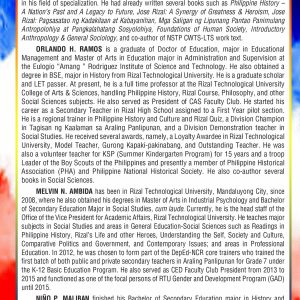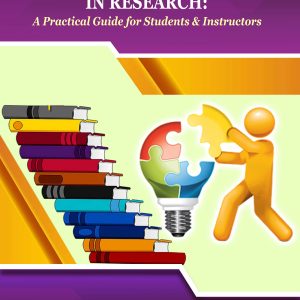NATIONAL DEVELOPMENT via NATIONAL SERVICE TRAINING PROGRAM – R.A. 9163 (CWTS 1)
ISBN: 971-0412-05-1
Author:Sonia Gasilla-Dela Cruz, Ed.D., LLB, D.P.A.
Edeliza G. Dela Cruz, Ed.D.
Paul M. Mapue, MAEd.
Description
ISBN: 971-0412-05-1
Author:Sonia Gasilla-Dela Cruz, Ed.D., LLB, D.P.A.
Edeliza G. Dela Cruz, Ed.D.
Paul M. Mapue, MAEd.
Additional information
| Book Type | Hard Copy, e-book |
|---|
Table of Contents
Foreword……………………………………………………………………………….. iii
Preface …………………………………………………………………………………… v
Acknowledgment……………………………………………………………………. vii
Dedication ……………………………………………………………………………. viii
Chapter 1
Implementing Rules and
Regulations of the National Service
Training program…………………………………………………………..1
Guiding Principles ……………………………………………………..2
Definitions of Terms ……………………………………………………2
Program Implementation …………………………………………….4
Components of the NSTP……………………………………………..4
Duration of the NSTP Components
and Equivalent Course per semester…………………………5
NSTP-One Summer Program………………………………………….5
How clustering and cross-enrollment can be done ………….6
Basic guidelines for the formulation of
the NSTP Curriculum ……………………………………………….7
Fees and Incentives ……………………………………………………8
Organization of NSTP Graduates ………………………………….8
Transitory Provisions ………………………………………………….9
Miscellaneous Provisions…………………………………………..10
Guidelines in the Implementation of the
National Service Program (NSP) at the
Higher Educational Level…………………………………………11
Worksheet No. 1 for Chapter 1……………………………………..15
Chapter 2
The Philippine Constitution …………………………………………..17
What Constitution is ………………………………………………….17
Citizens of the Philippines …………………………………………18
Duties and Obligations of Citizens ……………………………..18
Preamble of the 1987 Constitution………………………………20
The Basic Values of the Filipino People ………………………21
The Good Citizenship Value of Faith
in the Almighty ……………………………………………………..21
The Good Citizenship Value of Respect for Life……………22
The Good Citizenship Value of Order …………………………22
The Good Citizenship Value of Work ………………………….22
The Good Citizenship Value of Concern
for the Family and Future Generations …………………….23
The Good Citizenship Value of Love …………………………..23
The Good Citizenship Value of Freedom …………………….24
The Good Citizenship Value of Peace …………………………24
The Good Citizenship Value of Truth ………………………….25
The Good Citizenship Value of Justice ………………………..25
The Good Citizenship Value of Unity ………………………….26
The Good Citizenship Value of Equality………………………26
The Good Citizenship Value of Respect for
Law and Government ………………………………………….27
The Good Citizenship Value of Patriotism……………………27
The Good Citizenship Value of Promotion
of the Common Good …………………………………………….28
The Good Citizenship of Concern for the
Environment …………………………………………………………28
The Basic Building Blocks ………………………………………….29
Worksheet No. 2 for Chapter 2…………………………………..33
Values Education…………………………………………………………35
Chapter 3
Introduction……………………………………………………………..35
Types of Values ………………………………………………………..36
Values Formation through Community Service ……………37
Children Learn What They Live………………………………….38
The Meaning of Man as a Person ………………………………..39
Biblical Basis ……………………………………………………………40
The Self……………………………………………………………………41
Where Values Come From…………………………………………42
Core and Related Values …………………………………………..42
Worksheet No. 3 for Chapter 3…………………………………..45
Worksheet No. 4 for Chapter 3…………………………………..46
Chapter 4
Crime Prevention ………………………………………………………..47
What Crime is…………………………………………………………..48
Crime Prevention……………………………………………………..49
How to Minimize Crime……………………………………………..49
Community Involvement……………………………………………49
How to Keep your Family Safe ……………………………………50
How to Keep Children Safe………………………………………..51
Pointers for Children ………………………………………………..52
How to Keep Strangers Out………………………………………..53
How to Secure your Belongings………………………………….53
Do Not Fall to Cellphone Snatching…………………………….54
Do’s and Don’ts ………………………………………………………..55
Anti-Fencing Law (P.D. 1612)…………………………………….56
What to do if you are Under Threat …………………………….56
How to Avoid Rape……………………………………………………57
The Object is to get away with the least
injury to you …………………………………………………………..58
What to do if being attacked……………………………………….59
Protection from Bomb Threats ……………………………………59
Responding to Bomb Threats……………………………………..59
Person-to-Person or Direct Threat………………………………61
How to Save Lives……………………………………………………..61
What is “117?”………………………………………………………….61
Is “117” the Universal Emergency Number
for the Philippines …………………………………………………62
When to Use “117”……………………………………………………62
When not to Call “117” ……………………………………………..62
What “117” calls are considered Prank or
Illegitimate……………………………………………………………62
How to Call “117”……………………………………………………..63
Worksheet No. 5 for Chapter 4…………………………………..65
Worksheet No. 6 for Chapter 4…………………………………..66
Chapter 5
Calamity and Disaster Preparedness……………………………….67
Introduction……………………………………………………………..67
Categories of Disaster ………………………………………………68
Common Types of Disaster ………………………………………..70
The General Effects of Disaster ………………………………….70
Disaster Preparedness………………………………………………71
General Disaster Counter-Measures …………………………..71
Components of Disaster Management…………………………72
Objectives of Disaster Management……………………………72
Common Problems in Disaster Management……………….72
What can Influence Disaster Warning………………………….73
Disaster Management Policies……………………………………..73
Different Tasks of the National Disaster
Coordinating Council………………………………………………73
Members of the Council ……………………………………………..74
Contents of the National Disaster
Management Program……………………………………………..75
Suggestions to Enhance Community
Preparedness …………………………………………………………75
Worksheet No. 7 for Chapter 5……………………………………..77
Chapter 6
Surviving a Disaster (Precautionary Measures
Before, During and After a Disaster) ………………………………79
Surviving During Floods ……………………………………………79
Introduction……………………………………………………………..79
Definition of Terms……………………………………………………81
Floods ……………………………………………………………………..83
Protective measures before flood ……………………………….84
Protective measures during a flood…………………………….85
Preparation to evacuate ……………………………………………..85
Driving Flood Facts …………………………………………………..86
After a Flood…………………………………………………………….86
Worksheet No. 8 for Chapter 6…………………………………..89
Chapter 7
Earthquake (before, during and after)…………………………….91
Introduction……………………………………………………………..91
Definition of Terms……………………………………………………92
How earthquakes are measured…………………………………..93
Earthquake Intensity Scale ………………………………………….94
Protective measures before an earthquake…………………….99
Protective measures during an earthquake………………….101
Protective measures after an earthquake …………………….104
Worksheet No. 9 for Chapter 7……………………………………107
Fire prevention (before, during and after) ……………………..109
Chapter 8
Fire prevention (before, during and after) ……………………..109
Introduction…………………………………………………………….110
Nature of Fire…………………………………………………………..110
General categories of energy……………………………………111
Worksheet No. 10 for Chapter 8………………………………….117
Kitchen fires……………………………………………………………119
Classes of fire and how they are extinguished…………….121
Fire suppression and control …………………………………….123
Different types of portable fire extinguishers ………………123
Factors to be considered in the selection of
portable fire extinguishers…………………………………….124
Procedures in operating fire extinguisher ………………….124
Tips on what to do in case of fire–before and
during ………………………………………………………………..125
Worksheet No. 11 for Chapter 8………………………………….129
After Fire-Search and Rescue Operation………………………131
Initial Patient Assessment ………………………………………….132
What the first aider must do……………………………………..132
Essential things to remember …………………………………..133
How to cover burns with dry dressings
or sheets ……………………………………………………………..133
Worksheet No. 12 for Chapter 8………………………………….135
Chapter 9
Landslide (before, during and after)………………………. 137
Introduction……………………………………………………………137
Protective Measures………………………………………………..138
Before landslide ……………………………………………………..139
During landslide …………………………………………………….140
After landslide………………………………………………………..140
Worksheet No. 13 for Chapter 9 ……………………………….143
Chapter 10
Drought (before, during and after)………………………………145
Introduction……………………………………………………………145
Definition of drought ……………………………………………….146
Types of drought……………………………………………………..147
Some ways to save water ………………………………………….148
In the home…………………………………………………………….148
Outdoors ………………………………………………………………..149
Worksheet No. 14 for Chapter 10………………………………..151
Chapter 11
Tropical Cyclones (before, during and after)…………………..153
Introduction…………………………………………………………….153
Characteristics and formational of tropical
Cyclones……………………………………………………………..155
Cyclogenesis…………………………………………………………..155
Societal context and characteristics that
determine the societal impacts produced
by land falling tropical cyclones …………………………..157
Worksheet No. 15 for Chapter 11………………………………..159
Chapter 12
Health Education ………………………………………………………161
Introduction…………………………………………………………….161
Why we have to study health…………………………………….. 162
Principles Underlying Health …………………………………….162
Terms to be considered in studying health …………………163
Nutrition …………………………………………………………………164
Two classes of nutrients …………………………………………..164
Helpful tips in the selection, preparation,
cooking and serving of foods ………………………………..164
Food preparation and cooking to retain
Nutrients or prevent loss of nutrients………………………166
Cooking proper habits to maintain sanitation……………..167
The proper diet……………………………………………………….167
Basic elements in food……………………………………………..169
Balanced diet ………………………………………………………….171
Principles of hygienic food intake ……………………………..172
Worksheet No. 16 for Chapter 12………………………………..175
Fitness and healthy living…………………………………………177
Essential Facts which Man Should Know ………………………177
Worksheet No. 17 for Chapter 12………………………………..179
Chapter 13
Contagious Diseases………………………………………………….181
Carriers of Contagious Diseases ………………………………182
The Common Deficiency Diseases ……………………………183
Common Communicable Diseases……………………………184
Sore Eyes……………………………………………………………….184
Chronic Bronchitis ………………………………………………….184
Common Cold ………………………………………………………..185
Chickenpox ……………………………………………………………186
“El Tor” or Cholera…………………………………………………187
Whooping cough (Pertussis)…………………………………….188
Measles………………………………………………………………….189
Tuberculosis (TB)……………………………………………………192
Dengue fever………………………………………………………….193
Typhoid Fever ………………………………………………………..195
Mumps …………………………………………………………………..196
Worksheet No. 18 for Chapter 13 ……………………………..197
Aids update…………………………………………………………….201
Full blown aids (final stage) ……………………………………..202
Causes of aids…………………………………………………………202
HIV infection of aids not transmitted ………………………….202
Worksheet No. 19 for Chapter 13………………………………..205
Chapter 14
Alcoholism and Smoking……………………………………………..207
Introduction……………………………………………………………208
Alcoholic beverages ……………………………………………….208
Effects of alcohol in blood………………………………………..208
Reasons why people become alcoholic ……………………..208
Different ailments caused by heavy drinking………………209
Disadvantages and advantages of alcohol…………………..209
Alcohol in the body ………………………………………………….209
Alcohol and the diet…………………………………………………209
Worksheet No. 20 for Chapter 14………………………………..211
Smoking …………………………………………………………………214
Major health consequences of smoking……………………..214
Cancer …………………………………………………………………..214
Passive smoking ……………………………………………………..215
Health consequences of smoking………………………………216
Other risks caused by smoking………………………………..216
Worksheet No. 21 for Chapter 14 ……………………………..219
Chapter 15
Drug Education…………………………………………………………221
What drug is …………………………………………………………..221
When drugs are harmful…………………………………………..222
Are products other than drugs ever abused? ………………222
What drug abuse is …………………………………………………222
Why People Turn to Drugs…………………………………………222
Commonly Used Drugs …………………………………………….223
Detection When One is Abusing Drugs ……………………….224
Ill-effects of Drug abuse …………………………………………..225
What a Person can do to Prevent Drug Abuse ……………225
General Facts about Ecstasy…………………………………….226
Methods of Ecstasy Administration …………………………..226
Physiological Effects of MDMA…………………………………226
Psychological Effects of MDMA ………………………………..227
Long Term-Term Effects of MDMA ……………………………227
Short-Term Effects of MDMA…………………………………….228
Signs and Symptoms of MDMA …………………………………228
Profile of Users of MDMA…………………………………………228
Penalty…………………………………………………………………..229
Marijuana……………………………………………………………….229
Form of Marijuana …………………………………………………..229
Why Marijuana is Dangerous……………………………………229
Immediate Effects of Marijuana ………………………………..230
Long-Term Effects of Marijuana………………………………..230
What you should know about Inhalant abuse………………230
What is inhalant abuse? ……………………………………………230
Why is inhalant abuse dangerous ………………………………231
Immediate effects of inhalant abuse …………………………..231
Delayed effects of inhalant abuse ………………………………231
What you should know about opiates …………………………232
What opiates are …………………………………………………….232
Opiates which are abused………………………………………..232
Dangers of opiates abuse ………………………………………..232
Available Treatment for Opiates Abuse …………………….233
What you should Know about Cocaine………………………..234
What is Cocaine?……………………………………………………..234
Forms of Cocaine……………………………………………………..234
Risks of Cocaine Use ………………………………………………..235
Why Cocaine is Addicting…………………………………………235
Random Drug Testing for Secondary
and Tertiary Students …………………………………………….235
Who are going to be Tested? …………………………………….236
What agencies are participating
in this endeavor ……………………………………………………236
Do these agencies have the capability
to conduct the drug testing? …………………………………236
Responsibilities of DepEd, CHED, and TESDA
with regard to the implementation of the program ……………………………………………………………..237
Is there really a need to implement
a program of this kind? ………………………………………….237
How will the selection be done
since it is at random?…………………………………………….237
Who compose the Selection Board?……………………………237
Who shall be the Drug Testing Coordinator?………………..238
What are the responsibilities of the
Drug Testing Coordinator?……………………………………..238
If found to be positive for drugs, the student
may be a subject of discrimination
among his schoolmates. How will this
concern be prevented? ………………………………………..238
How is the process of rehabilitation done?………………….239
Who selects the Drug Counselor of the
school and what are his/her tasks? ………………………..239
If after the Counseling Period, the student
shows no sign of improvement.
What will be the next step? ……………………………………239
Can it be detected if the student is using
drugs for medical treatment
purposes and not for illegal use of the drug?…………….239
What if a student selected for the drug testing
refuses to undergo such test?
Will he be penalized for such an act?……………………….240
Who pays for the drug tests? …………………………………….240
Is there a penalty imposed on schools that
refuse to implement the drug-testing program?……….240
Worksheet No. 22 for Chapter 15 ……………………………….241
Worksheet No. 23 for Chapter 15 ……………………………….244
Chapter 16
First Aid ………………………………………………………………….245
What is first aid? …………………………………………………….246
First things first………………………………………………………246
The qualities of good first aider ……………………………….248
The need for first Aid ………………………………………………248
Nine general directions for first aiders………………………248
Three details to say when calling for a doctor……………..249
Where the Duty of the First Aider Starts and Ends …………249
Worksheet No. 24 for Chapter 16………………………………..251
The Recovery Position ………………………………………………253
Mouth-to-Mouth Resuscitation ……………………………………253
Cardiopulmonary Resuscitation (CPR) ………………………..254
First Aid for Common Accidents…………………………………254
What accidents are? ………………………………………………..254
Causes of accidents …………………………………………………255
Common accidents at home ……………………………………..255
Falls ………………………………………………………………………255
Burns……………………………………………………………………..256
Cuts and punctures …………………………………………………260
Bruises …………………………………………………………………..260
Electric shock…………………………………………………………261
Fainting………………………………………………………………….262
Animal bites …………………………………………………………..263
Severe bleeding……………………………………………………..266
Choking…………………………………………………………………267
Drowning……………………………………………………………….268
Fracture …………………………………………………………………269
Poisoning……………………………………………………………….272
Splinters in the skin ………………………………………………..273
Fish hook in the skin………………………………………………..273
Foreign bodies in the nose ……………………………………….273
Worksheet No. 25 for Chapter 16………………………………..275
Chapter 17
Family Planning…………………………………………………………277
Introduction……………………………………………………………277
Advantages of family planning………………………………….278
To the mother ……………………………………………………….278
What children will become through family planning ……279
For the father ……………………………………………………….279
To the family………………………………………………………..280
For the community……………………………………………….280
Methods of family planning……………………………………….280
Worksheet No. 26 for Chapter 17………………………………..287
Chapter 18
Good Parenting…………………………………………………………289
Introduction…………………………………………………………….289
Definition of responsible parenthood………………………….291
What parenting is ……………………………………………………291
Three aspects of parenting ……………………………………….292
How to become a good parent……………………………………292
Duties and responsibilities of parents …………………………295
Ten basic principles of good parenting ……………………….296
Worksheet No. 27 for Chapter 18………………………………..299
Chapter 19
Environmental Management………………………………………..301
Introduction……………………………………………………………301
Our environment……………………………………………………..302
Definition of terms …………………………………………………..303
Pollution …………………………………………………………………304
Environmental incidents……………………………………………306
Environmental protections should be everybody’s
concern………………………………………………………………307
The many faces of planet earth ………………………………….308
Environmental development ……………………………………..309
Types of wastes identified by RA 9003 ………………………..312
Worksheet No. 28 for Chapter 19………………………………..313
Worksheet No. 29 for Chapter 19………………………………..315
Chapter 20
Entrepreneurship……………………………………………………….317
Introduction……………………………………………………………317
Entrepreneurship defined ……………………………………….318
Entrepreneur defined………………………………………………. 319
Qualities of a good entrepreneurs ……………………………..320
Contributions of entrepreneurs ………………………………….323
Rewards that can be derived from
Entrepreneurship………………………………………………….325
Risks and trials in entrepreneurship……………………………326
Advantages of the small business……………………………….327
Planning a small business………………………………………….328
Selecting the line of business…………………………………….328
Worksheet No. 30 for Chapter 20………………………………..331
Chapter 21
Leadership Challenges for the Youth of
Today ……………………………………………………………………..333
Introduction…………………………………………………………….333
Functions of Leadership …………………………………………… 335
Three types of leadership………………………………………..335
Traits, which a leader should have…………………………….336
Characteristics of a leader………………………………………..336
Definition of terms …………………………………………………..337
Quotations about a leader ……………………………………….337
The Christian Leader………………………………………………..338
Worksheet No. 31 for Chapter 21………………………………..343
Worksheet No. 32 for Chapter 21………………………………..345
Chapter 22
Recreational Activities ……………………………………………….347
Introduction…………………………………………………………….347
Definition of terms …………………………………………………..348
Values of recreational activities…………………………………349
Types of recreational activities………………………………….350
Social activities ……………………………………………………….351
Musical activities …………………………………………………….351
Arts and crafts activities …………………………………………..352
Drama activities ………………………………………………………352
Dancing activities ……………………………………………………352
Nature and outing activities………………………………………352
Mental and linguistic activities………………………………….352
Service activities……………………………………………………..353
Recreational activities for the elderly …………………………353
Game classification …………………………………………………355
Choosing the right recreational sport ………………………..355
Benefits of recreational running………………………………..357
Running, a great form of entertainment……………………..357
Worksheet No. 33 for Chapter 22………………………………..359
Worksheet No. 34 for Chapter 22………………………………..361
References……………………………………………………………….363

